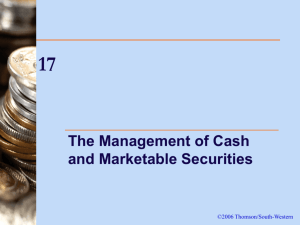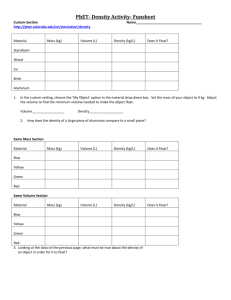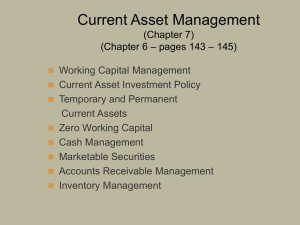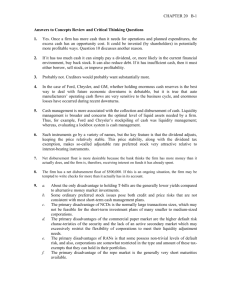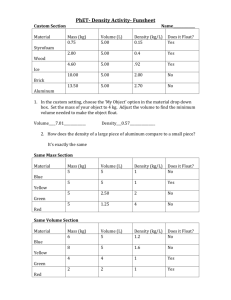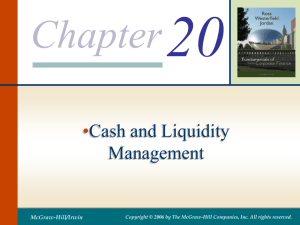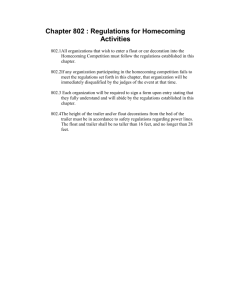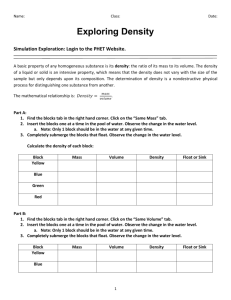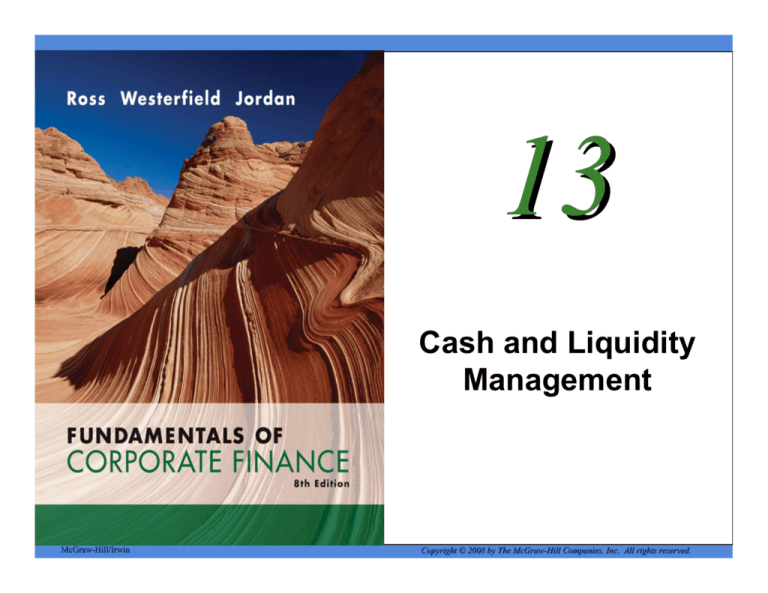
13
Cash and Liquidity
Management
McGrawMcGraw-Hill/Irwin
Copyright © 2008 by The McGrawMcGraw-Hill Companies, Inc. All rights reserved.
Chapter Outline
Reasons for Holding Cash
Understanding Float
Cash Collection and Concentration
Managing Cash Disbursements
Investing Idle Cash
Appendix
The Basic Idea
The BAT Model
The Miller-Orr Model: A More General Approach
Implications of the BAT and Miller-Orr Models
Other Factors Influencing the Target Cash Balance
13-1
Reasons for Holding Cash
Speculative motive – hold cash to take
advantage of unexpected opportunities
Precautionary motive – hold cash in
case of emergencies
Transaction motive – hold cash to pay
the day-to-day bills
Trade-off between opportunity cost of
holding cash relative to the transaction
cost of converting marketable securities
to cash for transactions
13-2
Understanding Float
Float – difference between cash balance
recorded in the cash account and the cash
balance recorded at the bank
Disbursement float
Generated when a firm writes checks
Available balance at bank – book balance > 0
Collection float
Checks received increase book balance before
the bank credits the account
Available balance at bank – book balance < 0
Net float = disbursement float - collection float
13-3
Example: Types of Float
You have $3,000 in your checking
account. You just deposited $2,000
and wrote a check for $2,500.
What is the disbursement float?
What is the collection float?
What is the net float?
What is your book balance?
What is your available balance?
13-4
Example: Measuring Float
Size of float depends on the dollar amount and
the time delay
Delay = mailing time + processing delay +
availability delay
Suppose you mail a check for $1,000 and it
takes 3 days to reach its destination, 1 day to
process, and 1 day before the bank makes the
cash available
What is the average daily float (assuming 30day months)?
Method 1: (3+1+1)(1,000)/30 = 166.67
Method 2: (5/30)(1,000) + (25/30)(0) = 166.67
13-5
Example: Cost of Float
Cost of float – opportunity cost of not being
able to use the money
Suppose the average daily float is $3 million
with a weighted average delay of 5 days.
What is the total amount unavailable to earn
interest?
5*3 million = 15 million
What is the NPV of a project that could reduce the
delay by 3 days if the cost is $8 million?
Immediate cash inflow = 3*3 million = 9 million
NPV = 9 – 8 = $1 million
13-6
Cash Collection
Payment
Mailed
Payment
Received
Mailing Time
Payment
Deposited
Processing Delay
Cash
Available
Availability Delay
Collection Delay
One of the goals of float management is to try to reduce the
collection delay. There are several techniques that can reduce
various parts of the delay.
13-7
Example: Accelerating Collections
– Part I
Your company does business nationally and
currently all checks are sent to the headquarters in
Tampa, FL. You are considering a lock-box system
that will have checks processed in Phoenix, St. Louis
and Philadelphia. The Tampa office will continue to
process the checks it receives in house.
Collection time will be reduced by 2 days on average
Daily interest rate on T-bills = .01%
Average number of daily payments to each lockbox is
5,000
Average size of payment is $500
The processing fee is $.10 per check plus $10 to wire
funds to a centralized bank at the end of each day.
13-8
Example: Accelerating Collections
– Part II
Benefits
Average daily collections = (5,000)(500) = 2,500,000
Increased bank balance = 2(2,500,000) = 5,000,000
Costs
Daily cost = .1(5,000) + 10 = 510
Present value of daily cost = 510/.0001 = 5,100,000
NPV = 5,000,000 – 5,100,000 = -100,000
The company should not accept this lock-box
proposal
13-9
Cash Disbursements
Slowing down payments can
increase disbursement float – but it
may not be ethical or optimal to do
this
Controlling disbursements
Zero-balance account
Controlled disbursement account
13-10
Investing Cash
Money market – financial instruments
with an original maturity of one year or
less
Temporary Cash Surpluses
Seasonal or cyclical activities – buy
marketable securities with seasonal
surpluses, convert securities back to cash
when deficits occur
Planned or possible expenditures –
accumulate marketable securities in
anticipation of upcoming expenses
13-11
Figure 20.6
13-12
Characteristics of Short-Term
Securities
Maturity – firms often limit the maturity of
short-term investments to 90 days to
avoid loss of principal due to changing
interest rates
Default risk – avoid investing in
marketable securities with significant
default risk
Marketability – ease of converting to cash
Taxability – consider different tax
characteristics when making a decision 13-13
Comprehensive Problem
A proposed single lockbox system will
reduce collection time 2 days on average
Daily interest rate on T-bills = .008%
Average number of daily payments to the
lockbox is 3,000
Average size of payment is $500
The processing fee is $.08 per check plus
$10 to wire funds each day.
What is the maximum investment that would
make this lockbox system acceptable?
13-14
Target Cash Balances
Target cash balance – desired cash level
determined by trade-off between carrying
costs and shortage costs
Flexible policy - if a firm maintains a
marketable securities account, the
primary shortage cost is the trading cost
from buying and selling securities
Restrictive policy – generally borrow
short-term, so the shortage costs will be
the fees and interest associated with
arranging a loan
13-15
Figure 20A.1
13-16
BAT Model
Assumptions
Cash is spent at the same rate every day
Cash expenditures are known with certainty
Optimal cash balance is where opportunity
cost of holding cash = trading cost
Opportunity cost = (C/2)*R
Trading cost = (T/C)*F
Total cost = (C/2)*R + (T/C)*F
C* =
2 TF
R
13-17
Example: BAT Model
Your firm will have $5 million in cash
expenditures over the next year. The
interest rate is 4% and the fixed
trading cost is $25 per transaction.
What is the optimal cash balance?
What is the average cash balance?
What is the opportunity cost?
What is the shortage cost?
What is the total cost?
13-18
Miller-Orr Model
Model for cash inflows and outflows
that fluctuate randomly
Define an upper limit, a lower limit,
and a target balance
Management sets lower limit, L
(target
C* = L + [(3/4)Fσ2/R]1/3
balance)
U* = 3C* - 2L (upper limit)
Average cash balance = (4C* - L)/3
13-19
Figure 20A.3
13-20
Example: Miller-Orr Model
Suppose that we wish to maintain a
minimum cash balance of $50,000.
Our fixed trading cost is $250 per
trade, the interest rate is .5% per
month and the standard deviation of
monthly cash flows is $10,000.
What is the target cash balance?
What is the upper limit?
What is the average cash balance?
13-21
Conclusions
The greater the interest rate, the lower
the target cash balance
The greater the fixed order cost, the
higher the target cash balance
It is generally more expensive to borrow
needed funds than it is to sell marketable
securities
Trading costs are usually very small
relative to opportunity costs for large
firms
13-22

